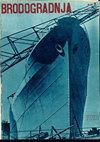UNMANNED SURFACE VEHICLE – TRITOR
IF 3.9
4区 工程技术
Q1 ENGINEERING, MARINE
引用次数: 1
Abstract
This paper presents an unmanned surface vehicle Tritor that was developed, constructed, and tested within an innovative, multi-purpose, multidisciplinary, low-budget and environmentally friendly solution. The idea behind this work was trying to invent a new concept of a miniature surface vehicle that will be unmanned, remotely controlled and autonomous, with electric propulsion, and with an innovative Three Slender Cylinders Hull (3SCH) form gaining advantages in comparison to existing surface vehicles. This initial work is focused on vehicle prototype design, propulsion system development and optimization, control design, and trials, while research related to advantages of the vehicle in terms of naval architecture criteria such as drag and power, stability, seakeeping, and maneuverability will be investigated in further work. In addition, the paper intends to contribute to a new trend in developing vehicles with electrical propulsion that could use renewable sources of energy such as wind and solar energy. The potential usage of the vehicle can be civilian or military, and further work will be focused on larger models, improved based on the experience got during the development of the vehicle. Tritor vehicle was successfully designed, constructed, and tested in real environmental conditions. The preliminary results show that the vehicle has required performances and potential for improvements in the future. The main scientific contribution of this work is advanced surface vehicle development with a focus on a new hull form and the integration of electric propulsion in it.无人水面飞行器
本文介绍了一种无人地面飞行器Tritor,该飞行器是在创新、多用途、多学科、低预算和环保的解决方案中开发、建造和测试的。这项工作背后的想法是试图发明一种微型水面车辆的新概念,该概念将是无人驾驶、远程控制和自动驾驶的,具有电力推进功能,并具有创新的三细长圆柱体船体(3SCH)形式,与现有的水面车辆相比获得优势。这项初步工作的重点是车辆原型设计、推进系统开发和优化、控制设计和试验,而与车辆在海军架构标准方面的优势相关的研究,如阻力和功率、稳定性、耐波性和机动性,将在进一步的工作中进行调查。此外,该论文旨在促进开发可使用风能和太阳能等可再生能源的电力推进车辆的新趋势。该车辆的潜在用途可以是民用或军用,进一步的工作将集中在更大的车型上,并根据车辆开发过程中获得的经验进行改进。Tritor运载工具已在实际环境条件下成功设计、建造和测试。初步结果表明,该车辆具有所需的性能和未来改进的潜力。这项工作的主要科学贡献是先进的水面车辆开发,重点是一种新的船体形式及其电力推进的集成。
本文章由计算机程序翻译,如有差异,请以英文原文为准。
求助全文
约1分钟内获得全文
求助全文
来源期刊

Brodogradnja
ENGINEERING, MARINE-
CiteScore
4.30
自引率
38.90%
发文量
33
审稿时长
>12 weeks
期刊介绍:
The journal is devoted to multidisciplinary researches in the fields of theoretical and experimental naval architecture and oceanology as well as to challenging problems in shipbuilding as well shipping, offshore and related shipbuilding industries worldwide. The aim of the journal is to integrate technical interests in shipbuilding, ocean engineering, sea and ocean shipping, inland navigation and intermodal transportation as well as environmental issues, overall safety, objects for wind, marine and hydrokinetic renewable energy production and sustainable transportation development at seas, oceans and inland waterways in relations to shipbuilding and naval architecture. The journal focuses on hydrodynamics, structures, reliability, materials, construction, design, optimization, production engineering, building and organization of building, project management, repair and maintenance planning, information systems in shipyards, quality assurance as well as outfitting, powering, autonomous marine vehicles, power plants and equipment onboard. Brodogradnja publishes original scientific papers, review papers, preliminary communications and important professional papers relevant in engineering and technology.
 求助内容:
求助内容: 应助结果提醒方式:
应助结果提醒方式:


